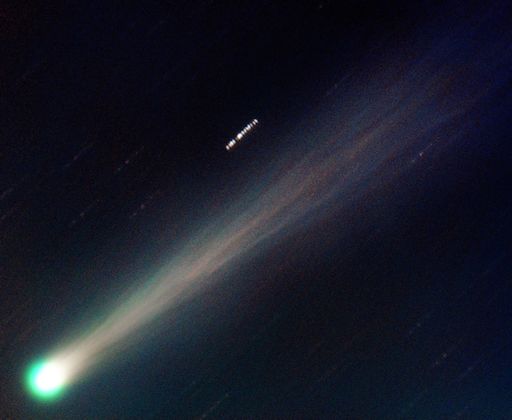COMET ISON PLUNGES TOWARD THE SUN: Comet ISON is plunging toward the sun at 140,000 mph (62 km/s). You can almost feel the velocity in this image taken on the morning of Nov. 20th by astronomers using the 0.4 meter telescope at the Observatorio de la Hita in La Puebla de Almoradiel, Toledo, Spain:
"The comet looked very bright," report the observing team. "The tail was not as well defined today because of the proximity of morning twilight...but still splendid!!"
The comet is brightening rapidly as it approaches the sun. Experienced observers put ISON's rising magnitude near +4.0, well above the threshold of naked-eye visibility. The problem is, the glare of the sun is brightening even faster. Amateur photography of the comet will be possible for a few more days and, soon, only NASA's fleet of solar observatories will be able to track the sundiver.
Observationally speaking, the next big event in the timeline of Comet ISON's journey comes on Nov. 21st when the comet enters the field of view of NASA's STEREO-A spacecraft. The Heliospheric Imager on STEREO-A will pick up the comet just as Earth-bound telescopes begin to lose it. In the days that follow, STEREO-B, SOHO and the Solar Dynamics Observatory will join the hunt, providing continuous views of Comet ISON all the way to perihelion (closest approach to the sun) on Nov. 28th. Stay tuned!

Solar wind
speed: 372.4 km/sec
density: 2.3 protons/cm3
explanation | more data
Updated: Today at 1757 UT
X-ray Solar Flares
6-hr max: C6 1722 UT Nov20
24-hr: C6 1722 UT Nov20
explanation | more data
Updated: Today at: 1800 UT
![]()
Daily Sun: 20 Nov 13
Crowded near the sun's SW limb, sunspots AR1893 and AR1897 pose a threat for M-class solar flares. Credit: SDO/HMI
![]()
Sunspot number: 113
What is the sunspot number?
Updated 20 Nov 2013
Spotless Days
Current Stretch: 0 days
2013 total: 0 days (0%)
2012 total: 0 days (0%)
2011 total: 2 days (<1%)
2010 total: 51 days (14%)
2009 total: 260 days (71%)
Since 2004: 821 days
Typical Solar Min: 486 days
Update 20 Nov 2013
The Radio Sun
10.7 cm flux: 153 sfu
explanation | more data
Updated 20 Nov 2013
![]()
Current Auroral Oval:
Switch to: Europe, USA, New Zealand, Antarctica
Credit: NOAA/POES
![]()
Planetary K-index
Now: Kp= 0 quiet
24-hr max: Kp= 2 quiet
explanation | more data
Interplanetary Mag. Field
Btotal: 3.0 nT
Bz: 1.4 nT south
explanation | more data
Updated: Today at 1756 UT
![]()
Coronal Holes: 20 Nov 13
There are no large coronal holes on the Earthside of the sun. Credit: SDO/AIA.





